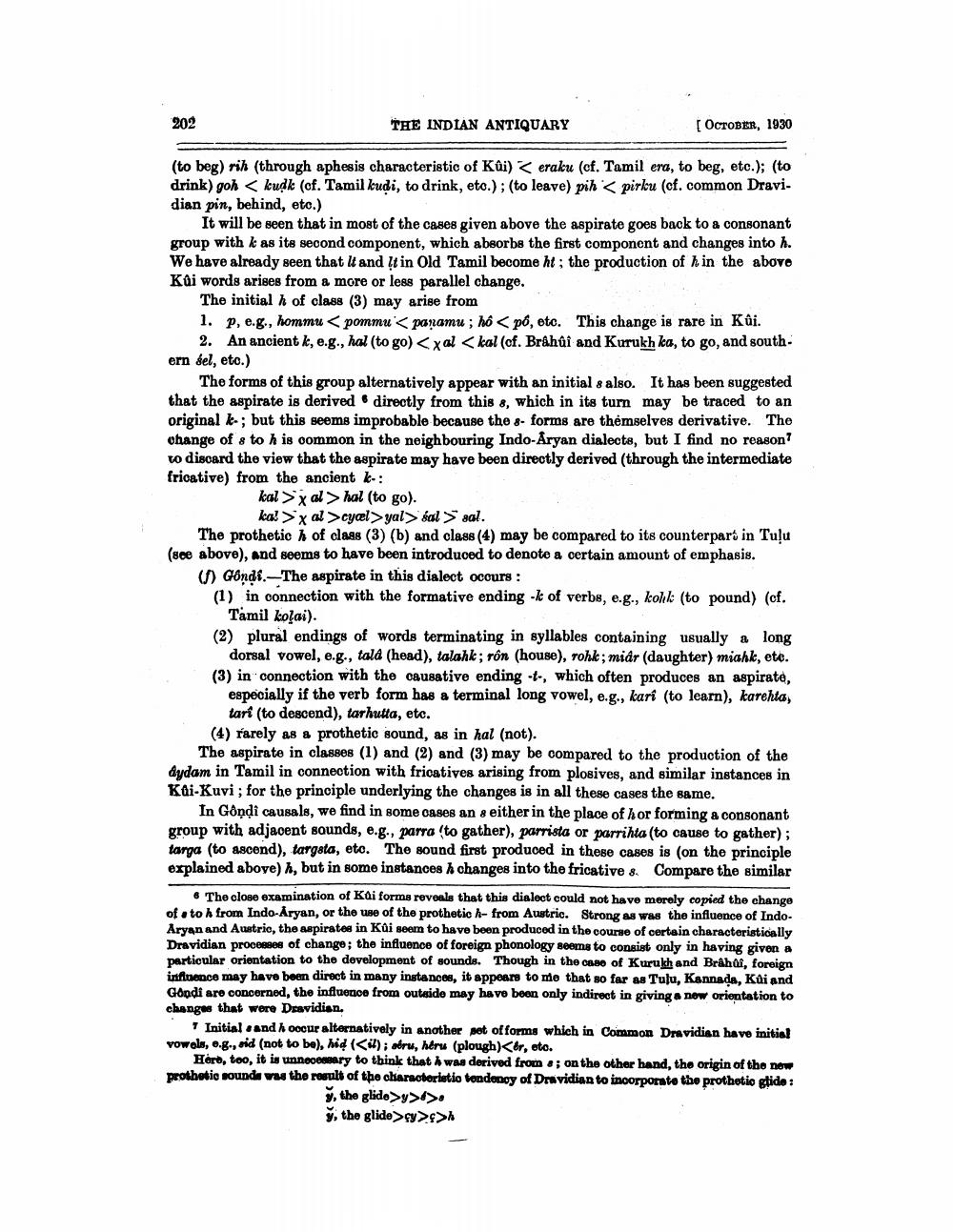________________
202
THE INDIAN ANTIQUARY
[ OCTOBER, 1930
(to beg) rih (through aphesis characteristic of Kûi) eraku (cf. Tamil era, to beg, etc.); (to drink) goh <kudk (of. Tamil keudi, to drink, eto.); (to leave) pih< pirlou (cf. common Dravi. dian pin, behind, etc.)
It will be seen that in most of the cases given above the aspirate goes back to a consonant group with k as its second component, which absorbs the first component and changes into h. We have already seen that it and It in Old Tamil become ht; the production of h in the above Kui words arises from a more or less parallel change.
The initial h of class (3) may arise from 1. P, e.g., hommu< pommu <paramu ; hô < pó, etc. This change is rare in Kûi.
2. An ancient k, e.g., hal (to go)<xal <kal (cf. Bråhui and Kurukh ka, to go, and southern sel, etc.)
The forms of this group alternatively appear with an initial s also. It has been suggested that the aspirate is derived directly from this s, which in its turn may be traced to an original k-; but this seems improbable because the 8- forms are themselves derivative. The change of sto h is common in the neighbouring Indo-Aryan dialects, but I find no reason? to discard the view that the aspirate may have been directly derived (through the intermediate fricative) from the ancient k
kal >x alhal (to go).
ka! >x al >cyæl>yal> salsal. The prothetic h of clans (3) (b) and class (4) may be compared to its counterpart in Tuļu (see above), and seems to have been introduced to denote a certain amount of emphasis.
(1) Gondi.-The aspirate in this dialect occurs : (1) in connection with the formative ending - k of verbs, e.g., kohl (to pound) (cf.
Tamil kolai). (2) plural endings of words terminating in syllables containing usually a long
dorsal vowel, e.g., tala (head), talahk; rôn (house), rohk; miar (daughter) miahk, ete. (3) in connection with the causative ending -t-, which often produces an aspirate,
especially if the verb form has a terminal long vowel, e.g., kari (to learn), karehta,
tari (to descend), tarhutta, etc. (4) rarely as a prothetic sound, as in hal (not).
The aspirate in classes (1) and (2) and (3) may be compared to the production of the dydam in Tamil in connection with fricatives arising from plosives, and similar instances in Kai-Kuvi; for the principle underlying the changes is in all these cases the same.
In Gôndi causals, we find in some cases an 8 either in the place of hor forming a consonant group with adjacent sounds, e.g., parra (to gather), parrista or parrihta (to cause to gather); targa (to ascond), targeta, etc. The sound first produced in these cases is (on the principle explained above), but in some instances h changes into the fricative 8. Compare the similar
& The close examination of Kdi forms reveals that this dialect could not have merely copied the change of a to h from Indo-Aryan, or the use of the prothetic h- from Austrio. Strong as was the influence of IndoAryan and Austrio, the aspirates in Kui seem to have been produced in the course of certain characteristically Dravidian procese of change; the influence of foreign phonology seems to consist only in having given a particular orientation to the development of sounds. Though in the case of Kurukh and Brahui, foreign influence may have been direct in many instances, it appears to mo that so far as Tulu, Kannada, Kúi and Gondi are concerned, the influence from outside may have been only indirect in giving a new orientation to changes that were Dravidian.
Initial e and hoocur alternatively in another set of forms which in Common Dravidian have initial Vowels, .g., id (not to be), hid (<); aru, héru (plough)<ér, eto.
Hero, too, it is unnecessary to think that I was derived from a; on the other hand, the origin of the new prothetic rounda was the result of the characteristio tondenoy of Dravidian to incorporate the prothetio gtide :
y the glide >>> y, the glide>$y>$>h




